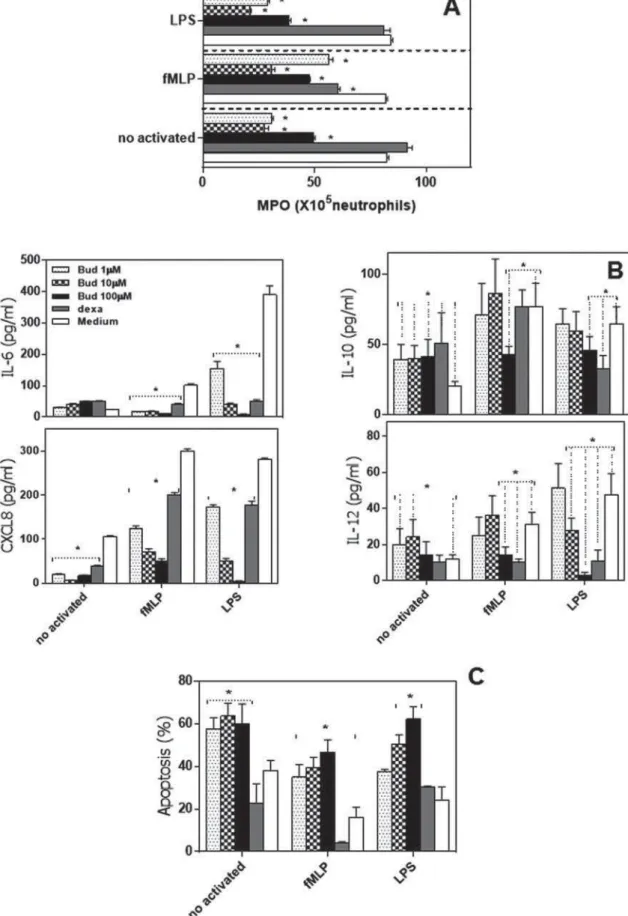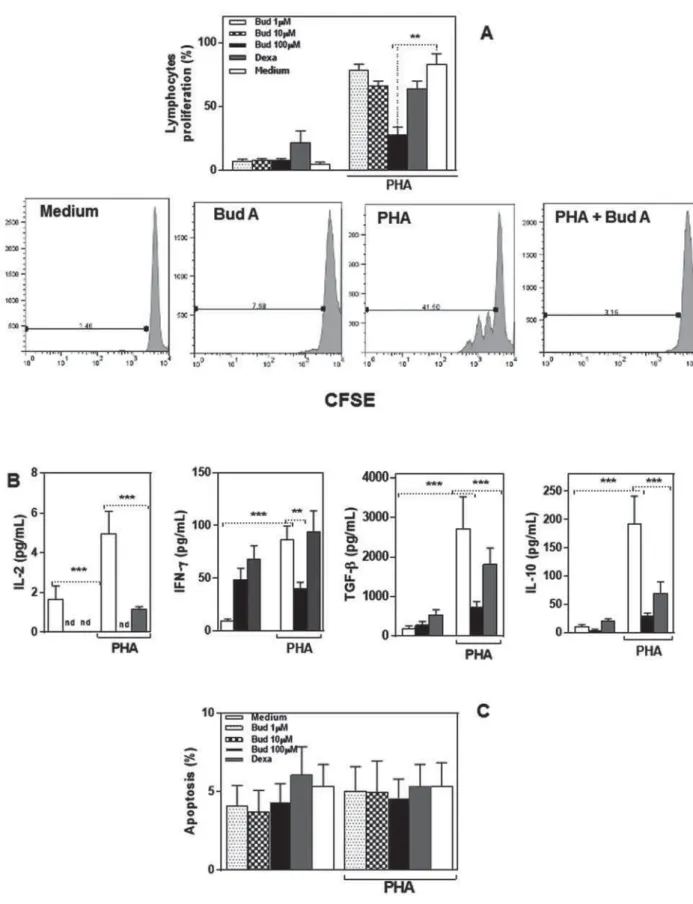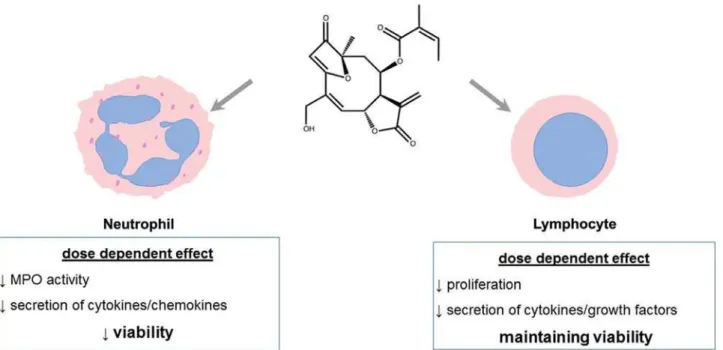ABSTRACT
Effects of budlein A on human neutrophils and
lymphocytes
Carollinie Dias KNOB1*, Milena da SILVA1*, Thaís Helena GASPAROTO1, Carine Ervolino de OLIVEIRA1, Nádia Ghinelli
AMÔR1, Nilton Syogo ARAKAWA2, Fernando Batista da COSTA3, Ana Paula CAMPANELLI1
1- Universidade de São Paulo, Faculdade de Odontologia de Bauru, Departamento de Ciências Biológicas, Bauru, SP, Brasil. 2- Universidade Estadual de Londrina, Londrina, PR, Brasil.
3- Universidade de São Paulo, Faculdade de Ciências Farmacêuticas de Ribeirão Preto, Departamento de Farmacognosia, Ribeirão Preto, SP, Brasil.
*Both authors have equally collaborated in this investigation.
Corresponding address: Ana Paula Campanelli - Departamento de Ciências Biológicas - Faculdade de Odontologia de Bauru - Universidade de São Paulo - Al. Octávio Pinheiro Brisolla, 9-75 - 17012-901 - Bauru - São Paulo - Brazil - Phone +55 14 3235 8271 - Fax: 55 14 3235 8271 - e-mail: apcampan@usp.br
Submitted: November 26, 2015 - Accepted: January 27, 2016
S
esquiterpene lactones (SLs) are the active constituents of a variety of medicinal plants ailments. Objective: In this study, we evaluated whether budlein A modulates the activation of innate and adaptive immune cells such as neutrophils and lymphocytes. Material and Methods: Our research group has investigated several plant species and several compoundsisolated from the species Aldam a buddlej iform is and A. robust a (Ast eraceae) and shows
derived substances modulate the activation of innate and adaptive immune cells have led to the development of new therapies for human diseases. Results: Budlein A inhibited MPO activity, IL-6, CXCL8, IL-10, and IL-12 production and induces neutrophil apoptosis.
production, but it did not lead to cell death. Conclusions: Collectively, our results indicate that budlein A shows distinct immunomodulatory effects on immune cells.
Keyw ords: Lactones. Neutrophils. Lymphocytes.
I N TRODUCTI ON
The ability of the immune system to respond to a variety of stimuli is central to its function in pathogen clearance and tissue repair4. The
in different pathological settings is maintained by
signaling6, and most research has focused on
understanding the mechanisms that regulate the immune response4,6,8,9. New therapeutic agents
are currently under investigation for pathological conditions in which the balance between activation and suppression of the immune response has failed6. Studies have shown that plant-derived
compounds have immunomodulatory effects without direct immunosuppressive action such as clinically used corticosteroids2,3,16,27.However, the
mere isolation of new naturally-occurring anti-drug until the exact mechanism of action and their possible toxic effects are completely determined9.
Moreover, many biologically active compounds that do not afford a new drug or even a principal compound can be used as prototypes for the study of the mechanisms involved in a certain biological effect. Budlein A, a sesquiterpene lactone (SL) formerly isolated from the Central American species
Aldam a buddlej ifor m is (DC)1 and more recently
from the South American A. r ob u st a Gar d n er
(Ast er aceae), has been described as presenting
1,7,27. Recent studies have
activities in mice22,27. Although this information is
affects other cells, adaptive immune response and T cell compartment. An immunomodulatory substance might show antibacterial activity, but the induced cell death could also be harmful to immune responses, pathogen clearance and tissue repair11,18. In this context, research to develop new
by lymphocyte activation, has been stimulated.
Given the broad information relating SLs and immunomodulation, we should evaluate whether budlein A modulates the activation of innate and adaptive immune cells.
MATERI AL AN D METHODS
Budlein A
Budlein A (MW=374.1365) was isolated from the leaves of Vig u ier a r ob u st a, as previously described27. Its chemical structure was determined
by means of spectrometric analysis, i.e., IR, 1H, and 13C nuclear magnetic resonance (NMR) spectrometry as well as comparison with an authentic sample and data reported in literature5.
Analytical procedures using spectroscopy and chromatographic techniques indicated that the purity of budlein A used in this study ranged between 95-98%. Prior to the bioassays, budlein A was dissolved in dimethylsulfoxide (DMSO) (SIGMA – St. Louis, MO, USA) (0.1% in RPMI 1640 medium – GIBCO – Grand Island, NY, USA).
Healt hy volunt eers
We used peripheral blood from 30 healthy volunteers (17 men and 13 women; age ranged between 27-50 years). All subjects had no active diseases at the time of phlebotomy. All subjects signed an informed consent releasing the use of blood for research purposes approved by the Bauru School of Dentistry, University of São Paulo.
I solat ion of leukocyt es
Peripheral blood was harvested with heparin (50 U/ml) from healthysubjects. Both groups of leukocytes were layered over two different density Histopaque gradients (SIGMA) and centrifuged for 30 min at 450X g. Peripheral blood mononuclear Histopaque 1077) and neutrophils were isolated from the second buffy coat layer (onto Histopaque 1119). Cells were then washed twice with Roswell Park Memorial Institute medium (RPMI) at 200 X g cells was >99% viable when assessed by Trypan blue exclusion.
N eut rophils cult ure
Neutrophils (1x106/well)from healthy donors
were cultured in 24-well plates,in presence of medium only, or Lipopolysaccharide (LPS) (10 ng/ mL), N-for m y l- m et hionine-leucine-pheny lalanine
(fMLP) (1.5 μM) in presence or absence of different concentrations of budlein A (1, 10 or 100 μM) or dexamethasone (100 μM).
T cell cult ure and proliferat ion assays
(CFSE) (Invitrogen – Eugene, OR, USA) labeled-PBMC (1x106/well)from healthy donors were cultured in
24-well plates,in the presence of phytohaemagglutinin (PHA) (1 μg/ml) (SIGMA), or in presence or absence of different concentrations of budlein A (1, 10, or 100 μM) or dexamethasone (100 μM), at 37°C and 5% CO2.On day 4, the cells were harvested and the proliferative response of T cells was assessed by The proliferation of T cells was characterized by equally spaced peaks on a logarithmic scale. The data represents the percentage of proliferation of T cells.The cellacquisition was performed on a (BD Biosciencess – San Diego, CA, USA).
Myeloperoxidase act ivit y
Myeloperoxidase (MPO) activity was determined by enzymatic reaction, as previously described26.
Neutrophils were harvested after culture and centrifuged at 350X g for 15 min, and the pellet and centrifuged twice at 10,000X g for 15 min at 4°C. The MPO activity in the suspended pellet was assayed by measuring the change in absorbance at 450 nm using tetramethylbenzidine (1.6 mM) and H2O2 (0.5 mM) (BD Biosciences).
Cyt okine assays
Interleukin (IL)-2, IL-6, CXCL8, IL-10, IL-12,
Biosciences or R&D Systems – Minneapolis, MN, USA), according to the manufacturer’s instructions.
Apopt osis
Cells were harvested after culture and the viability was analyzed by flow cytometry, as previously described26. The percentage of apoptotic
cells was calculated from the proportion of neutrophils, as well as lymphocyte positivity for Annexin- V-FITC or propidium iodide (ApoScreen™ Annexin V-FITC kit, SouthernBiotech – Birmingham, AL, USA), in relation to total number of cells26. St at ist ical analysis
Values are presented as mean±SEM. Statistical analysis was performedusing ANOVA followed
Figure 1- Budlein A negatively regulated the neutrophil activation to fMLP and LPS. Neutrophils from healthy controls were
FXOWXUHGZLWKPHGLXPRQO\RUEXGOHLQ$ȝ0ȝ0RUȝ0GH[DPHWKDVRQHȝ0EXGOHLQSOXVI0/3RUEXGOHLQ
plus LPS. (A) Analysis of myeloperoxidase activity (MPO). B) IL-6, CXCL8, IL-10, and IL-12 production were analyzed by ELISA. (C) Flow cytometric analysis of apoptosis. The bars represent the mean±SEM for each volunteer individually
by the Tukey’s multiple comparisontest (INSTAT Software; GraphPad Prism, La Jolla, CA, USA). All values were considered
RESULTS
Budlein A inhibit s M PO a ct ivit y, cyt ok ine p r o d u c t i o n , a n d i n d u c e s n e u t r o p h i l apopt osis
budlein A on neutrophils, cells were stimulated with fMLP or LPS in presence or absence of budlein A (1, 10, or 100 μM) or dexamethasone (positive control), and the myeloperoxidase (MPO) activity, IL-6, CXCL8, IL-10, and IL-12 production and apoptosis were analyzed. Consistent with prior observation27,
budlein A inhibited in a concentration-dependent manner the MPO activity by LPS-stimulated-neutrophils (Fig. 1A). Our results also indicate that at a concentration of 10 and 100μM, budlein A reduced MPO activity by fMLP-stimulated neutrophils (Figure 1A).
Because neutrophils appear to be important producers of cytokines during innate immune response and cytokines are important mediators of the inflammatory process, we assessed whether budlein A affects cytokine and chemokine production by neutrophils (Figure 1B). Unstimulated neutrophils produced basal levels of IL-6, IL-10, CXCL8, and IL-12. Budlein A decreased CXCL8 production, induced IL-10 production and did not alter IL-12 and IL-6 production by unstimulated neutrophils. After 21 h of culture, LPS and fMLP enhanced IL-6, CXCL8, IL-12, and IL-10 production by human neutrophils. In contrast, budlein A inhibited in a concentration-dependent manner IL-6 and CXCL8 production by fMLP and LPS-stimulated neutrophils. Moreover, budlein A, at only 100 μM concentration, inhibited IL-10 and IL-12 production by fMLP and LPS-stimulated-neutrophils, while at 10 μM it inhibited IL-12 production by LPS-activated neutrophils (Figure 1B). To verify whether the results were the consequence of cell death, we analyzed the apoptosis of neutrophils. Our data showed that only budlein A at 100 μM concentration significantly induced neutrophil apoptosis (33.19±5.70%), similar to that observed after culture with dexamethasone (22.83±0.51%) (Figure 1C). Similar results were observed when fMLP or LPS-stimulated neutrophils were treated with budlein A (100 μM) (Figure 1C).
Budlein A inhibit ed T cell proliferat ion
To determine the anti-inflammatory effects of budlein A on lymphocytes, cells were cultured with PHA in presence or absence of budlein A (1, 10, or 100 μM) or dexamethasone (positive
Lymphocytes exhibit proliferative response after PHA stimulation, and the addition of budlein A (100
μ
2A). These results indicate that budlein A interferes with PHA-induced T cell proliferation. Regarding cytokine production, the results evidenced that
μ
lymphocytes, with similar effects to dexamethasone (Figure 2B).
Since budlein A negatively modulates the secretion of cytokines by PHA-stimulated lymphocytes, and this could be a consequence of cell death, their apoptosis was evaluated (Figure 2C). We found that budlein A (1, 10, or 100 μM) does not induce lymphocyte apoptosis (Figure 2C). These data indicate that budlein A exerts an important role against lymphocytes’ activation, but it did not induce cell death.
DI SCUSSI ON
Although budlein A has been described as activity1,7,27
immune cells are lacking. In the present study, we demonstrated that budlein A inhibit neutrophils activation and induce cell death, but, despite also inhibiting lymphocyte activation, it did not induce lymphocyte death.
Budlein A inhibited in a concentration-dependent manner the release of biochemical mediators by neutrophils, and this activity could possibly reduce tissue damage caused by the enzyme24,28. The
MPO activity can be deleterious to the host, and it has been implicated in the pathogenesis of many
21. Myeloperoxidase has also
been established as a risk factor for many forms of cancer via its ability to damage/mutate cellular
9,21.
via the inhibition of nuclear factor-kappa B (NF-the p65 subunit18, impairing its activation and
the consequent production of inflammatory mediators15,17.
Another important effect of budlein A on neutrophils shown in this study was the inhibition of IL-6, CXCL-8, IL-10, and IL-12 production.
Pro-modulate the late events to control the immune response23. The imbalance between pro- and
anti-inflammation and autoimmune diseases8,20,23.
Imbalance in the production of inflammatory
Figure 2- Budlein A inhibited T cell proliferation. (A) Flow cytometric analysis of proliferative response of PBMC cultured with Budlein A, dexamethasone, and PHA (1.5 mM) for 96 h. (B) IL-2, IFN-gamma, TGF-beta, and IL10 concentration in supernatant were analyzed by ELISA. (C) Flow cytometric analysis of apoptosis. The bars represent the mean±SEM of
YDOXHVREWDLQHGIRUHDFKVXEMHFWLQGLYLGXDOO\WHVWHGSSSZDVFRQVLGHUHGVWDWLVWLFDOO\VLJQL¿FDQW
Figure 3- Graphical abstract showing effects of Budlein A on human neutrophils and lymphocytes
cytokines may allow a local inflammation to response8,20,21.
Because low cytokine production might have occurred as a consequence of cytotoxic effects exerted by budlein A, we analyzed the apoptosis of human neutrophils. Only budlein A, at the 100
μM concentration, induces neutrophils apoptosis. The death of neutrophils observed in this study may be due to the absence of growth factors, particularly CXCL8, since budlein A, as well as other sesquiterpenes, inhibits activation of NF-neutrophil survival1,23. In fact, 1 μM of budlein A
CXCL8 either. Another possible explanation could survival. Death of neutrophil induced by budlein A could be harmful to immune response, pathogen clearance, and tissue repair24,25. Neutrophils are
microenvironment as well26. The precise regulation
of neutrophil apoptosis is essential for resolution of intracellular components that can damage healthy tissues10,12,19,26
induced neutrophil apoptosis would only be helpful in some chronic inflammatory diseases, since mediators avoiding their resolution12,26,27. A plethora
oxygen species or neutrophil extracellular traps) is produced by viable neutrophils13,28. These mediators
levels and by different ways, such as directly through the inhibition of cytokines, modulating their production or damaging surrounding tissues14,28.
Several diseases seem to be affected by activated neutrophils, including rheumatoid arthritis (RA) and systemic lupus erythematosus (SLE)13,14,28.
Hence, reduced numbers of activated neutrophils might generate a protected microenvironment from dramatic consequences from their uncontrolled
29.
Interestingly, despite previous studies having shown that high concentrations of sesquiterpene lactones induced apoptosis of PBMC30, we did not
using three different concentrations of budlein A.
μ
proliferation via other sesquiterpenes; however, the viability rate of the cells had not been evaluated23.
Here, inhibition of lymphocyte proliferation might be a consequence of undetectable levels of IL-2, an important cytokine inducing lymphocyte proliferation. Thus, budlein A might be an important inhibitor of uncontrolled lymphocyte proliferation without inducing their apoptosis. Such situation would facilitate their use in diseases without directly affecting their survival.
Therefore, our results also show that budlein A induced apoptosis of neutrophils but not lymphocytes, and indicate that budlein A shows distinct immunomodulatory effects on immune cells (Figure 3).
CON CLUSI ON S
budlein A reveal an important potential to the study of mechanisms of action and therapeutics1,5. In the
present study, we demonstrated that budlein A inhibits neutrophil activation and induces cell death, but, despite also inhibiting lymphocyte activation, it did not induce lymphocyte death. Further studies
diseases. It will be of interest to evaluate how the balance between these positive and negative effects could be regulated during the course of the immune response.
ACKN OW LEDGEMEN TS
The authors would like to thank FAPESP - support (2008/57149-8). The authors were supported by FAPESP [scholarship granted to C.D.K (2008/09554-0) and M.S. (2008/03931-Technological Development (scholarship granted to F. B. Da C., and A.P.C.).
REFEREN CES
1- Arakawa NS, Schorr K, Ambrósio SR, Merfort I, Costa FB. Further sesquiterpene lactones from Viguiera robust a and the potential
neutrophil elastase release. Z Naturforsch C. 2008;6:533-8.
cytokines, chemokines and adhesion molecules. Planta Med. 2004;70:93-103.
3- Cho JY, Baik KU, Jung JH, Park MH. I n vit ro
effects of cynaropicrin, a sesquiterpene lactone, from Saussurea lappa. Eur J Pharmacol. 2000;398:399-407.
4- Ciraci C, Janczy JR, Sutterwala FS, Cassel SL. Control of innate
2012;14:1263-70.
5- Costa FB, Schorr K, Arakawa NS, Schilling EE, Sprin GO.
two Brazilian Viguiera species (Heliantheae; Asteraceae). J. Braz. Chem. Soc. 2001;12:403-7.
6- De la Fuente H, Cibrián D, Sánchez-Madrid F. Immunoregulatory
immune response. FEBS Lett. 2012;586:2897-905.
7- De Vivar AR, Guerrero C, Diaz E, Bratoeff EA, Jiménez L. The germacranolides of Viguiera buddleiaeform is structures of budlein-A and -B. Phytochemistry. 1976;15:525-9.
8- Demoruelle MK, Deane KD, Holers VM. When and where does
2014;26:64-71.
9- Federico A, Morgillo F, Tuccillo C, Ciardiello F, Loguercio C. Chronic inflammation and oxidative stress in human carcinogenesis. Int J Cancer. 2007;121:2381-6.
Periodontol 2000. 2013;63:149-64.
11- Geetha BS, Nair MS, Latha PG, Remani P. Sesquiterpene lactones isolated from Elephant opus scaber L. inhibits human lymphocyte proliferation and the growth of tumour cell lines and induces apoptosis in v it r o. J Biomed Biotechnol. 2012;2012:721285.
12- Getts DR, McCarthy DP, Miller SD. Exploiting apoptosis for therapeutic tolerance induction. J. Immunol. 2013;191:5341-6. 13- Huang X, Li J, Dorta-Estremera S, Di Domizio J, Anthony SM, Watowich SS, et al. Neutrophils regulate humoral autoimmunity by
oxygen species. Cell Rep. 2015;12:1120-32.
14- Kaplan MJ. Role of neutrophils in systemic autoimmune diseases. Arthritis Res Ther. 2013;15:219.
15- Lawrence T. The nuclear factor NF-kappa B pathway in
16- Lee HJ, Kim NY, Jang MK, Son HJ, Kim KM, Sohn DH, et al. A sesquiterpene, dehydrocostus lactone, inhibits the expression of inducible nitric oxide synthase and TNF-alpha in LPS-activated macrophages. Planta Med. 1999;65:104-8.
17- Lee HK, Song HE, Lee HB, Kim CS, Koketsu M, Ngan LT, et al. Growth inhibitory, bactericidal, and morphostructural effects of dehydrocostus lactone from Magnolia sieboldii leaves on antibiotic-susceptible and -resistant strains of Helicobact er pylori. PLoS One. 2014;9:e95530.
18- Lyss G, Knorre A, Schmidt TJ, Pahl HL, Merfort I. The
transcription factor NF-kappa B by directly targeting p65. J Biol Chem. 1998;273:33508-16.
19- McCracken JM, Allen LA. Regulation of human neutrophil apoptosis and lifespan in health and disease. J Cell Death. 2014;7:15-23.
20- McInnes IB, Schett G. Cytokines in the pathogenesis of rheumatoid arthritis. Nat Rev Immunol. 2007;7:429-42. 21- Mika D, Guruvayoorappan C. Myeloperoxidase: the yin and yang in tumour progression. J Exp Ther Oncol. 2011;9:93-100. 22- Nicolete R, Arakawa NS, Rius C, Nomizo A, Jose PJ, Costa FB, et al. Budlein A from Viguiera robust a inhibits leukocyte-endothelial
mediators release. Phytomedicine. 2009;16:904-15.
23- Perez DA, Vago JP, Athayde RM, Reis AC, Teixeira MM, Sousa LP, et al. Switching off key signaling survival molecules
2014;2014:829851.
24- Rijken F, Bruijnzeel-Koomen CA. Photoaged skin: the role of neutrophils, preventive measures, and potential pharmacological targets. Clin Pharmacol Ther. 2011;89;120-4.
25- Smith CK, Kaplan MJ. The role of neutrophils in the pathogenesis of systemic lupus erythematosus. Curr. Opin. Rheumatol. 2015;27:448-53.
26- Tessarolli V, Gasparoto TH, Lima HR, Figueira EA, Garlet TP,
after infection with Candida albicans. Med Mycol. 2010;48:129-40. 27- Valério DA, Cunha TM, Arakawa NS, Lemos HP, Costa
of the sesquiterpene lactone budlein A in mice: inhibition of cytokine production-dependent mechanism. Eur J Pharmacol. 2007;562:155-63.
28- Witko-Sarsat V, Rieu P, Descamps-Latscha B, Lesavre P, Halbwachs-Mecarelli L. Neutrophils: molecules, functions and pathophysiological aspects. Lab Invest. 2000;80:617-53. 29- Yu Y, Koehn CD, Yue Y, Li S, Thiele GM, Hearth-Holmes MP,


